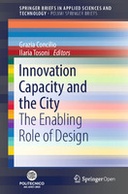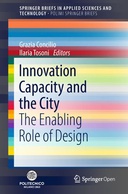Explore

Innovation Capacity and the City: The Enabling Role of Design
This book makes up one of the key milestones of the DESIGNSCAPES project, an H2020 CSA (Coordination and Support Action) funded by the European Commission under the Call entitled “User-driven innovation: value creation through Design Enabled Innovation”. The Action started in June 2017 and currently involves 12 public and private organizations (mostly academia and local government associations, plus an international news aggregator) from 10 EU Member States, under the leadership of ANCI Toscana, the free association of Tuscan Municipalities. The project, as is clear from its full title, aims to build a European capability for Design Enabled Innovation (henceforth: DEI) within the public as well as the private sector, thus meeting a precise requirement of the H2020 Call. However, it does so by taking a relatively unexplored (by previous researchers and practitioners) perspective. In fact, available evidence from both scientific and grey literature highlights the role and importance of design and design thinking for urban development processes, or puts emphasis on the City as testbed or ‘lighthouse’ of smart technological and social innovation. To this evidence, DESIGNSCAPES adds an original analysis of the visible and hidden connections between the urban context, or ‘scape’, in which public and private organizations are embedded, and their propensity and capabilities to use design effectively when innovating products, processes and methods of work. This book is the result of the first 6 months of such analysis and is, therefore, to be considered as a work in progress—although most of the content that will follow does already demonstrate sufficient robustness, at least from a scientific point of view, to appear convincing and encouraging to the policy-oriented reader, until any contrary evidence is found out. In addition, the main research avenues presented herein are influencing and shaping the imminent launch of yet another exciting initiative of our Action: a funded call for pilot proposals, which will be open to any individual, private or public body, in order to demonstrate adherence to the H2020 Call plea for more extended DEI take-up, while at the same time revealing some of the less obvious v ‘plots’ documenting the connection between the ‘Urbanscape’ and the intensity or quality or efficiency of that take-up.
This book is included in DOAB.
Why read this book? Have your say.
You must be logged in to comment.
Rights Information
Are you the author or publisher of this work? If so, you can claim it as yours by registering as an Unglue.it rights holder.Downloads
- 21 - pdf (None) at Google Books.
- 105 - pdf (CC BY) at OAPEN Library.
- 107 - mobi (CC BY) at Unglue.it.
- 139 - epub (CC BY) at Unglue.it.
- 69 - pdf (CC BY) at Unglue.it.
Keywords
- Design-enabled Innovation
- Designscapes
- Economics
- Economics, finance, business & management
- Geography
- Open Access Book
- Smart cities
- Society & Social Sciences
- Sociology
- Sociology & anthropology
- Sociology, Urban
- thema EDItEUR::J Society and Social Sciences::JH Sociology and anthropology::JHB Sociology
- thema EDItEUR::K Economics, Finance, Business and Management::KC Economics::KCV Economics of specific sectors::KCVS Regional / urban economics
- Urban economics
- Urban Environments
- urban geography
- Urban Governance
- urban planning
- Urbanscape
Links
DOI: 10.1007/978-3-030-00123-0web: https://link.springer.com/book/10.1007/978-3-030-00123-0
Editions


